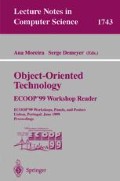Abstract
This article summarizes the workshop on human factors in use cases and object-oriented development methods. The following questions were the main focus of the workshop: Can use cases be improved by the incorporation or consideration of formal task analysis models and human centered design techniques in general? Are there ways of integrating human factors and user-centered techniques into use cases and object-oriented methods? The workshop brought a multidisciplinary blend of researchers and practitioners involved in user-centered design together with those interested by user requirements and use cases. It highlighted fundamental problems arising from the integration of human factors in use cases and OO methods.
Access this chapter
Tax calculation will be finalised at checkout
Purchases are for personal use only
Preview
Unable to display preview. Download preview PDF.
References
J.M. Artim, M. Van Harmelen, et al. Incorporating work, process and task analysis into commercial and industrial object-oriented systems development. ACM SIGCHI Bulletin, 30(4), oct 1998.
S. Balbo. Évaluation ergonomique des interfaces utilisateur: un pas vers l’automatisation. PhD thesis, University of Grenoble, Grenoble, France, sep 1994.
G. Booch, J. Rumbaugh, and I. Jacobson. The Unified Modeling Language User Guide. Addison Wesley, Reading, MA, 1999.
P. Brun and M. Baudouin Lafon. A taxonomy and evaluation of formalisms for the specification of interactive systems. In Proceedings of HCI’95, 1995.
M. Christensen et al. The M.A.D. experience: Multi-perspective Application Development in evolutionary prototyping. In Proceedings of the 12th European Conference on Object-Oriented Programming (ECOOP’ 98), 1998.
A. Cockburn. Structuring use cases with goals. Journal of Object-Oriented Programming, 10(7), 1997.
P. Forbrig and C. Stary. From task to dialog: How many and what kind of models do developers need? (CHI workshop “from task to dialogue: Task-based user interface design”), 1998.
ISO. ISO/DIS 13407 standard: Human centered design processes for interactive systems. Technical report, ISO, 1998.
I. Jacobson, M. Christerson, et al. Object-Oriented Software Engineering: A Use Case Driven Approach. Addison Wesley, Reading, MA, 1992.
P. Kruchten. The Rational Unified Process-An Introduction. Addison Wesley, Reading, MA, 1999.
P. Letelier, I. Ramos, P. Sanchez, and O. Pastor. OASIS version 3.0: A formal approach for object oriented conceptual modeling. Technical Report SPUPV-98.4011, Technical University of Valencia, Spain, 1998.
M.D. Lozano, I. Ramos, and P. Cuenca. Application of an object-oriented methodology for automatic software production: OO-Method. In Proceedings of the IEEE Pacific Rim Conference on Communications, Computers and Signal Processing (PACRIM’97), 1997.
O. Pastor, E. Insfran, V. Pelechano, J. Romero, and J. Meseguer. OO-Method: An OO software production environment combining conventional and formal methods. In Proceedings of the 9th International Conference, CAiSE’97, 1997.
J. Rumbaugh, I. Jacobson, and G. Booch. The Unified Modeling Language Reference Manual. Addison Wesley, Reading, MA, 1999.
R. Vinter, M. Loomes, and D. Diana Kornbrot. Applying software metrics to formal specifications: A cognitive approach. In Proceedings of the Fifth IEEE International Software Metrics Symposium, 1998.
Author information
Authors and Affiliations
Editor information
Editors and Affiliations
Rights and permissions
Copyright information
© 1999 Springer-Verlag Berlin Heidelberg
About this paper
Cite this paper
Seffah, A., Hayne, C. (1999). Integrating Human Factors into Use Cases and Object-Oriented Methods. In: Moreira, A. (eds) Object-Oriented Technology ECOOP’99 Workshop Reader. ECOOP 1999. Lecture Notes in Computer Science, vol 1743. Springer, Berlin, Heidelberg. https://doi.org/10.1007/3-540-46589-8_14
Download citation
DOI: https://doi.org/10.1007/3-540-46589-8_14
Published:
Publisher Name: Springer, Berlin, Heidelberg
Print ISBN: 978-3-540-66954-8
Online ISBN: 978-3-540-46589-8
eBook Packages: Springer Book Archive

